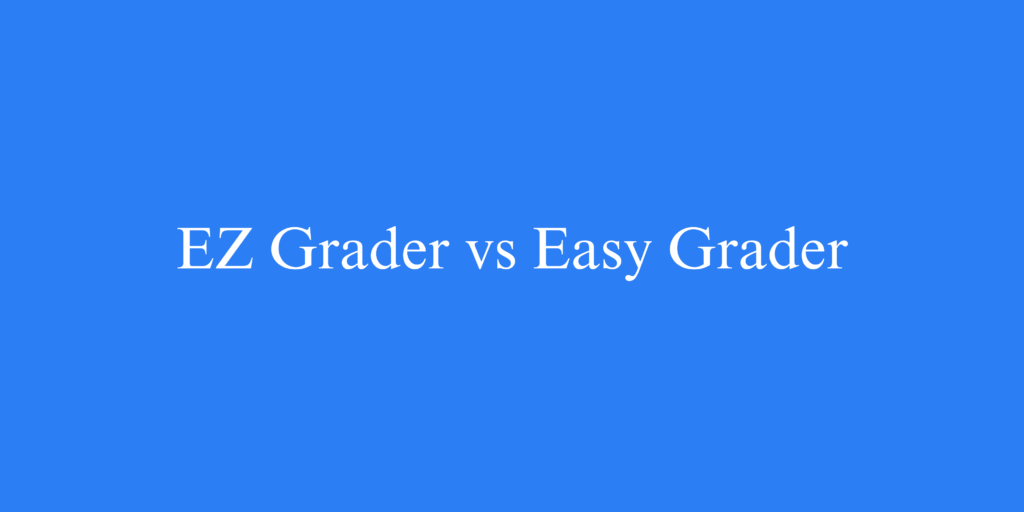EZ Grader vs. Easy Grader: What’s the Difference?
Grading tests and assignments can be a tedious task for teachers but tools like EZ Grader and Easy Grader make it faster and more accurate. If you are wondering whether these two grading calculators are different or which one is better for your needs, this article will clarify everything in simple terms. Designed for educators, students and parents, this guide compares EZ Grader and Easy Grader, highlighting their features and differences to help you choose the right tool for your classroom.

What Is EZ Grader?
EZ Grader is a well-known brand that started as a physical grading tool, a cardboard slide chart used to calculate percentage scores. Teachers input the total number of questions and the number of incorrect answers and the tool provides the percentage score instantly. Today, EZ Grader also offers digital versions, including online calculators and mobile apps, making it a versatile choice for modern educators.
Key Features of EZ Grader
- Physical Slide Chart: A durable, portable tool for grading tests with up to 95 questions. It is simple to use and built to last, with some teachers using the same chart for years.
- Digital Options: Available as apps or online tools, such as those on the App Store, supporting up to 500 questions.
- Customizable Grading: Digital versions let you adjust grade scales (e.g, 90 – 100% = A) to match your school’s system.
- Accuracy: Eliminates manual calculation errors, ensuring reliable results.
EZ Grader is ideal for teachers who want a trusted, straightforward grading calculator that works both in-hand and online.
What Is Easy Grader?
Easy Grader is a general term for any tool that simplifies grading by calculating percentage scores and letter grades. Unlike EZ Grader, which is a specific brand, Easy Grader refers to a variety of online calculators, apps or other grading tools. These are often digital first, designed for quick access and modern functionality, making them popular among tech savvy educators.
Key Features of Easy Grader
- Online Accessibility: Web based tools, like those found on Education Wise work on any device with an internet connection.
- Flexible Features: Many Easy Graders support advanced options like weighted grades, bonus points or custom grade scales.
- Free to Use: Most online versions are free, with some offering premium features like gradebook integration.
- Eco Friendly: Digital tools reduce the need for physical materials, supporting sustainable practices.
Easy Grader tools are perfect for teachers who prefer digital solutions and need flexibility for larger or more complex assessments.
EZ Grader vs. Easy Grader: Key Differences
While both EZ Grader and Easy Grader serve the same purpose, making grading quick and accurate. They differ in branding, format and features. Here’s a clear comparison to help you understand the distinctions:

Branding
- EZ Grader: A specific, trademarked brand with a long history of providing reliable grading tools, both physical and digital.
- Easy Grader: A generic term for any grading calculator, including EZ Grader and other tools available online or as apps.
Format
- EZ Grader: Offers both a physical slide chart (typically $7-$10) and digital versions (free or with paid features). The physical chart is great for teachers who like a hands-on tool.
- Easy Grader: Primarily digital, available through websites or apps, making it accessible anywhere without the need for a physical device.
Features
- EZ Grader: Focuses on simple percentage calculations, handling up to 95 questions (physical) or 500 (digital). Some apps allow custom grade scales or half point scoring.
- Easy Grader: Often includes advanced features like weighted grades, support for larger tests or integration with digital grade books, depending on the platform.
Cost
- EZ Grader: Physical charts require a one-time purchase, while digital versions are often free with optional in-app purchases.
- Easy Grader: Most online tools are free, with premium features available via subscriptions on some platforms.
User Appeal
- EZ Grader: Best for educators who trust a well-known brand and prefer a physical tool or simple digital interface.
- Easy Grader: Suited for those who want a modern, digital-first grading calculator with extra features and no physical clutter.
In short, EZ Grader is a branded tool with a legacy in both physical and digital formats, while Easy Grader refers to a range of digital grading tools, often with more advanced options.
Which Should You Choose?
Choosing between EZ Grader and Easy Grader depends on your grading needs and preferences:
- Choose EZ Grader if you want a reliable, branded tool especially if you prefer a physical slide chart for quick grading or a simple digital version for tests with up to 95 questions.
- Choose Easy Grader if you need a free, digital tool with advanced features like weighted grades or support for larger tests, accessible on any device.
For example, a middle school teacher grading a 30 question quiz might opt for a physical EZ Grader for its ease, while a college professor handling a 200 question exam might prefer an online Easy Grader for its flexibility.
Conclusion
Both EZ Grader and Easy Grader are excellent grading calculators that save time and ensure accuracy for educators. EZ Grader is a trusted brand offering physical and digital tools, ideal for simple grading tasks. Easy Grader refers to a variety of digital tools, often with advanced features for more complex assessments. Whether you choose the classic EZ Grader or a versatile Easy Grader, both will streamline your grading process, letting you focus on teaching.
